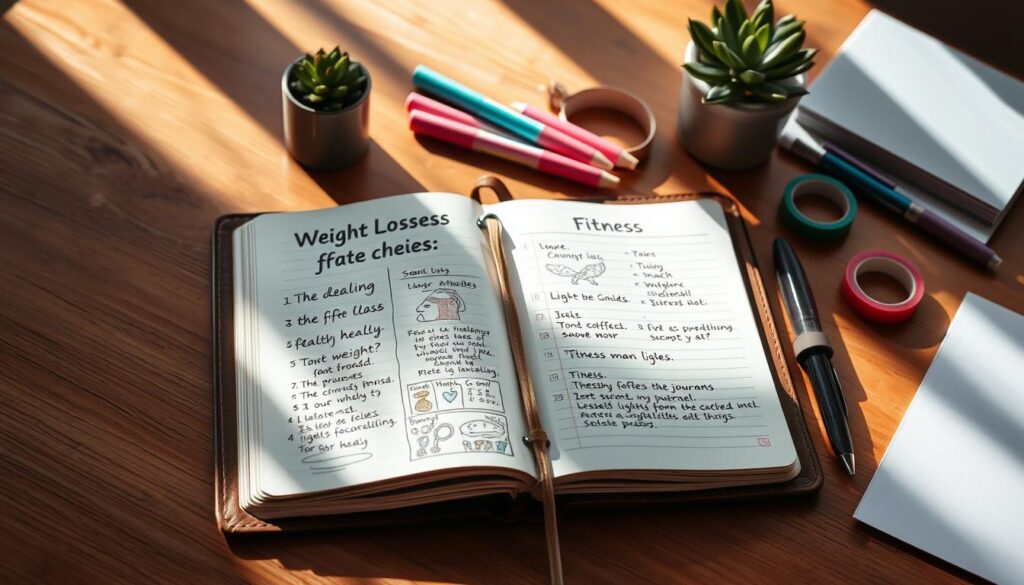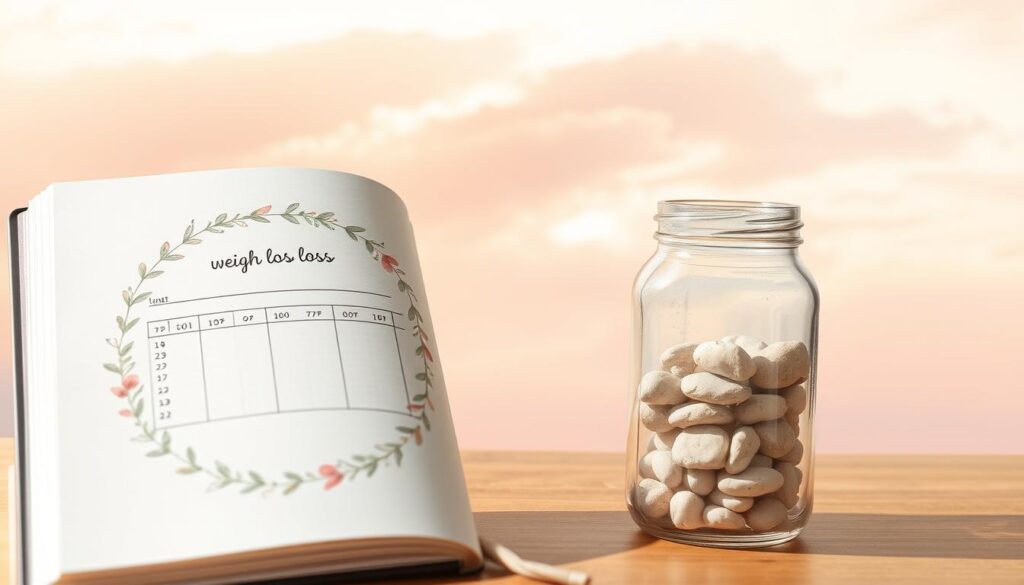Weight Loss Journaling Ideas to Achieve Your Goals
Starting a weight loss journey can be tough. But, with the right tools, you can stay on track. Journaling is a great way to monitor your progress.
By writing down your daily experiences, thoughts, and feelings, you learn a lot. You can spot patterns and make better choices. This helps you on your weight loss journey.
Find out how journaling ideas keep you motivated and focused. In this article, we’ll look at the benefits of weight loss journaling. We’ll also share practical tips to start.
Key Takeaways
- Learn how journaling supports your weight loss goals
- Discover practical journaling ideas to stay motivated
- Understand the benefits of tracking your progress
- Find tips to get started with weight loss journaling
- Explore how journaling can help you make informed decisions
The Power of Journaling for Weight Loss Success
Adding journaling to your daily routine can make your weight loss journey more mindful and effective. It’s not just about logging your food or workouts. It’s a tool to understand your habits, spot patterns, and make better health choices.
How Journaling Creates Accountability
Journaling helps you stay accountable in your weight loss journey. By writing down your goals, progress, and challenges, you’re more likely to stick to your plan. Accountability is key to success, as it makes you honest about your eating and exercise habits.

The Psychological Benefits of Writing Down Your Journey
Journaling also boosts your mental health, which aids in weight loss. Writing down your thoughts and experiences can lower stress and boost motivation. Reflecting on your journey can reveal insights into your food and body relationship, leading to healthier habits.
Research Supporting Journaling for Weight Management
Studies prove journaling is effective for managing weight. People who keep a food diary are more likely to reach their weight loss goals. Journaling helps track progress, spot improvement areas, and lead to lasting lifestyle changes.
Using journal prompts for healthy living and weight loss reflection prompts can guide your reflection. These tools ensure you cover all aspects of your weight loss journey.
Getting Started with Your Weight Loss Journal
Starting a weight loss journey needs planning. One key step is beginning a weight loss journal. This tool helps you track your progress and understand your habits.
Choosing the Right Journal Format
You can pick between digital and physical journals for weight loss. A digital journal is easy to use anywhere with a mobile app. A physical journal lets you write, draw, and collage, offering a hands-on experience.
Think about these points when picking your journal:
- Ease of use
- Personal preference
- Accessibility
Essential Supplies for an Effective Weight Loss Journal
To get the most from your journal, you’ll need some basic items. These include:
- A dedicated notebook or journal
- Colorful pens or markers for creative expression
- Stickers or washi tape for decoration
- A ruler or straightedge for creating graphs and charts

Setting Up Your First Pages
Begin by making an index or table of contents. This makes it easier to find your way as your journal grows. Then, create a page for your weight loss goals. Write down your short-term and long-term goals.
Creating a Sustainable Journaling Routine
To make journaling a habit, set a regular time and place. Start with small goals, like journaling for 5-10 minutes a day. As you get more comfortable, you can write for longer periods.
Effective Weight Loss Journaling Ideas to Transform Your Journey
To change your weight loss journey, you need a smart journaling plan. Use the right tools and methods every day. This will help you move closer to your goals.
Daily Food and Calorie Tracking Templates
Tracking your food and calories daily is key. Use templates to log what you eat. This helps spot patterns and choose better foods.
Example of a Daily Food Log: Make a table with columns for meal time, food, portion size, and calories. It shows your eating habits and helps you make better choices.
Workout and Physical Activity Logs
It’s just as important to track your workouts. Logs help you keep up with your exercise and see how you’re doing. They show which exercises work best and help you avoid getting stuck.
Tip: Write down the type of exercise, how long, and how hard it was. This gives a full picture of your activity.

Emotional Eating Triggers Documentation
Knowing why you eat emotionally is key to changing your habits. Write down what makes you eat when you shouldn’t. Find better ways to deal with stress, boredom, or other feelings.
Progress Measurement Systems
Tracking your progress keeps you motivated. Use weight charts, body measurements, and photos to see how far you’ve come. Looking at your progress helps you stay on track and adjust your plan if needed.
Progress Tracking Tip: Mix measurements like weight, body fat, and photos. This gives a full view of your progress.
Creative Bullet Journal Layouts for Weight Loss Tracking
Bullet journaling has made tracking weight loss more fun and personal. It lets people see their progress in a creative way. This approach not only helps reach weight loss goals but also makes the journey enjoyable.
Key to a good weight loss bullet journal are different layouts for various aspects of the journey. Let’s look at some of these creative layouts.
Monthly Weight Trackers and Graphs
Monthly trackers and graphs are vital for seeing progress over time. They turn your weight loss journey into a visual story. Tracking your monthly progress with a graph can be really helpful.

Habit Trackers for Healthy Behaviors
Habit trackers keep you consistent with healthy habits like exercise and sleep. They help you stay on track to your weight loss goals. Creating a habit tracker that fits your life can really boost your weight loss.
Meal Planning Spreads
Meal planning is key to weight loss. A dedicated spread for meal planning helps organize your diet. Planning your meals can prevent unhealthy choices.
Before and After Documentation
Recording your before and after progress is powerful. Photos and measurements motivate you. Looking back at your progress helps spot areas to improve.
Using these creative bullet journal layouts makes weight loss tracking more fun and effective. Whether you’re new to journaling or experienced, these ideas can inspire a personalized weight loss system.
Powerful Journal Prompts for Weight Loss Reflection
To get the most out of your weight loss journal, it’s key to use reflection prompts. Journaling helps you understand your habits and progress. This leads to successful weight loss. With powerful prompts, you can learn a lot about your journey and make changes.
Exploring Your Relationship with Food
Understanding your food relationship is key for weight loss. Use these self-discovery questions to learn about your eating:
- What are my favorite comfort foods, and why do I turn to them?
- How do I eat when stressed or emotional?
- What are my healthiest eating habits, and how can I improve them?

Setting Goals for Success
Clear goals are vital for weight loss success. Use these prompts to set and keep goals:
- What are my short-term weight loss goals, and how can I reach them?
- What are my long-term goals, and how can I break them down?
- How will I keep track of my progress?
Cultivating Gratitude and Positivity
Gratitude and positivity keep you motivated. Try these exercises:
- Write three things you’re grateful for each day about your weight loss.
- Reflect on your progress and celebrate your wins.
- How can you use positive affirmations daily?
Overcoming Challenges
Weight loss journeys face challenges, but reflection helps. Use these prompts to stay on track:
- What challenges have I faced, and how did I overcome them?
- What strategies can I use for future challenges?
- How can I learn from setbacks and grow?
| Reflection Prompt | Purpose | Benefits |
|---|---|---|
| Self-discovery questions | Understand your relationship with food | Gain insight into eating habits |
| Goal-setting prompts | Set clear goals for weight loss | Stay on track and achieve success |
| Gratitude exercises | Cultivate positivity and gratitude | Stay motivated and focused |
| Overcoming challenges prompts | Reflect on challenges and overcome obstacles | Learn from setbacks and stay on track |
By using these journal prompts, you can gain insights, stay motivated, and reach your goals.
Using Your Journal to Identify Patterns and Triggers
Your journal is more than just a record of your weight loss progress. It’s a key to understanding the factors that influence your success. By tracking various aspects of your daily life, you can identify patterns and triggers that impact your weight loss journey.
Tracking Mood and Energy Levels
Recording your mood and energy levels daily can help you understand how different factors affect your weight loss. For instance, you might notice that your energy levels dip on days when you don’t get enough sleep or when you’re under stress. Using a simple rating system (e.g., 1-5) can make it easy to track these metrics daily.
![]()
Identifying Environmental and Social Influences
Your environment and social interactions can significantly influence your eating habits and exercise routine. By noting the settings and company you keep during meals and workouts, you can identify patterns that either support or hinder your progress. For example, you might find that you’re more likely to overeat at social gatherings or that you’re more motivated to exercise with a friend.
Connecting Sleep Patterns to Weight Loss Progress
Sleep plays a crucial role in weight loss. Tracking your sleep patterns can reveal how rest affects your weight loss efforts. You might discover that on nights when you get less sleep, you’re more inclined to crave unhealthy snacks the next day. Creating a table like the one below can help visualize this connection:
| Date | Sleep Duration (hours) | Cravings for Unhealthy Snacks |
|---|---|---|
| 2023-03-01 | 7 | No |
| 2023-03-02 | 5 | Yes |
| 2023-03-03 | 8 | No |
Analyzing Stress and Its Impact on Eating Habits
Stress can have a significant impact on your eating habits, often leading to emotional eating or cravings for comfort foods. By tracking your stress levels and noting how you respond to them, you can develop strategies to manage stress more effectively. Recognizing the signs of stress early can help you intervene before it affects your eating habits.
By using your journal to identify these patterns and triggers, you can make informed decisions to adjust your weight loss strategy. This will lead to more successful weight loss tracking and achieving your weight loss journaling ideas.
Maintaining Motivation Through Journal Visualization Techniques
Journaling is more than just tracking your progress. It’s about seeing yourself succeed. By using visualization in your journal, you can stay motivated and focused on your weight loss goals.
Creating Vision Boards in Your Journal
A vision board is a powerful tool for visualizing your goals. Start by collecting images, quotes, and other items that inspire you. Choose images that show your weight loss goals, like healthy meals or your ideal body shape. Arrange them in a way that feels meaningful to you, adding personal touches like stickers or markers.
Milestone Celebration Pages
Celebrating your milestones is key to staying motivated. Set aside pages in your journal to celebrate your achievements. Document your progress with photos, measurements, or notes about how you feel. Reflecting on your successes keeps you positive and encouraged.
Inspirational Quote Collections
Inspirational quotes can motivate you. Create a section in your journal for quotes that inspire your weight loss journey. You can find these online, in books, or create your own. Use different fonts or colors to make it visually appealing.
Non-Scale Victory Documentation
Non-scale victories are achievements that aren’t just about the number on the scale. Documenting these victories shows the broader impact of your efforts and keeps you motivated.
Overcoming Plateaus with Journal Reflections
Plateaus are a normal part of weight loss. When you hit one, use your journal to reflect and find the cause. Ask yourself questions like “What have I been eating?” or “Has my exercise routine changed?” Use this reflection to adjust your strategy and move past the plateau.
By using these visualization techniques in your journal, you can stay motivated and keep moving towards your weight loss goals. The key is to stay engaged and inspired throughout your journey.
Advanced Weight Loss Journaling Strategies
Advanced weight loss journaling strategies offer a deeper way to reach your goals. They use detailed tracking methods. This helps you understand your journey better and make informed decisions.
Macro and Micronutrient Tracking Systems
Tracking your macro and micronutrients is key. It means logging proteins, carbs, fats, vitamins, and minerals daily. This helps spot patterns and adjust your diet for better weight loss.
| Nutrient | Daily Target | Actual Intake |
|---|---|---|
| Protein | 100g | 90g |
| Carbohydrates | 200g | 220g |
| Fat | 70g | 65g |
Intermittent Fasting Logs
Keeping a log is crucial for intermittent fasting. It tracks fasting periods and eating times. This helps see how your body reacts to different fasting plans.
- Record your fasting and eating windows
- Note any challenges or successes
- Adjust your schedule as needed based on your log
Fitness Challenge Documentation
Documenting fitness challenges boosts motivation and accountability. Tracking workouts and progress keeps you focused on your goals.
- Choose a fitness challenge that aligns with your goals
- Log your daily workouts and progress
- Celebrate your achievements along the way
Recipe Collection and Meal Success Stories
Collecting healthy recipes and sharing meal success stories is inspiring. It introduces new meal ideas and reinforces good eating habits. It’s a fun way to explore different cuisines while staying on track.
Combining Health Metrics for Comprehensive Tracking
Tracking various health metrics like weight, body fat, sleep, and energy gives a full picture of your health. This approach helps find areas for improvement and track progress over time.
Key Takeaway: Advanced weight loss journaling strategies offer a detailed and nuanced view of your journey. They help you understand and improve your progress.
Conclusion: Transforming Your Weight Loss Journey Through the Power of Journaling
Journaling is a powerful tool for reaching your weight loss goals. By adding weight loss journey journal ideas to your daily routine, you gain insight into your food and body relationship.
Good journaling is not just about tracking progress. It’s about using weight loss reflection prompts to understand your reasons, hurdles, and wins. Reflecting helps you spot patterns and triggers that affect your weight loss.
Keep in mind that journaling is a personal and ongoing journey. Be patient, stay dedicated, and celebrate your achievements. With determination and the right attitude, you can hit your weight loss targets and live a healthy, balanced life.




